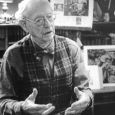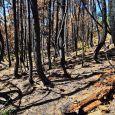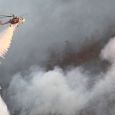The Gift of South Dakota
Subscriptions to South Dakota Magazine make great gifts!
Subscribe today — 1 year (6 issues) is just $29!
Fire Bomber
 |
| Spearfish pilot Arnold Kolb (far left) and his crew used a fleet of refurbished B-17 bombers to fight forest fires. |
A photograph shows a relaxed Arnold Kolb standing near his B-17 bomber the way other men pose with a newly acquired sports car. Yes, Kolb loved flying. But this airplane meant business. He and his crews used it to douse forest fires. Their daring adventures and remarkable record of success earned Kolb and the pilots of Black Hills Aviation a reputation that quickly spread from their base in Spearfish across North America.
Those who witness wildfires may say, “Better to face them from high in the sky than up close.” That’s not how Kolb worked. He swooped in so low that afterwards pine needles were sometimes found in his wing flaps.
“I looked out and saw treetops at eye level,” recalls Rick Plocek, who worked for Kolb on the ground out of high school and memorably flew to a Black Hills fire with him. “Then the load dropped, and it felt like being in an elevator when it starts, like you’re weightless for a second.”
Among fellow pilots, Kolb held a reputation for being able to drop slurry on a dime and for being creative when necessary. One time, firefighters on the ground were trapped on a ridge with flames moving toward them. Pamela Parker recalls how her father made a drop so that slurry backsplash drew a line between the firefighters and the fire, saving their lives. Slurry dropped directly on people would have killed them as surely as flames, but with the steady Kolb at the controls, that would never happen.
Born in 1927 on the Kolb family ranch near Bison, Arnold was the fifth of nine children. Most of the siblings remained closely associated with one another through aviation over the course of their lives. It was a time when airplanes were transforming South Dakota ranching by reducing isolation, moving cattle, rounding up renegade horses, crop dusting and more.
Arnold’s older brother, Raymond, taught him to fly in 1945. Like so many of his generation, Arnold grew up fast. By age 21 he was vice president of a family flight enterprise in Lemmon. He married Florence Dutton, and they had four daughters and two sons.
The Kolbs bought lots of planes. “I know there’s money in aviation because I put a lot of it there,” Arnold once quipped. If he had an instinct for flying, he also possessed one for business. He would make back his investments many times over and survive considerable economic turbulence.
In 1958 Arnold and Florence bought How Kola Flying Service of Spearfish. “The concern,” reported a local paper, “which operates under a lease agreement at the county-owned airport, will be known in the future as Black Hills Aviation. Kolb is a flight instructor, a commercial pilot with instrument rating and an aircraft and engine mechanic …. Black Hills Aviation will sell and service airplanes, offer ambulance and charter service, do flight instruction and crop dusting.”
Spearfish was an airplane town, first intrigued by flight when Kansas City daredevil Crash-‘Em Up Smith thrilled it with stunts in 1912. Homestake Gold Mine’s Ed Curren led efforts to build the airport in 1922. The next decade saw Works Progress Administration (WPA) labor build a distinctive native stone administration building with a tower, and crowds gathered for an annual air show. Spearfish was home to Clyde Ice, a central figure in daring medical emergency flights and advisor to Henry Ford’s aviation production efforts. In short, there was no place in South Dakota better equipped with flight expertise and airplane mechanics. But in many cases Arnold had to look no further than his own brothers, especially Delbert, a pilot and gifted mechanic and fabricator.
 |
| Kolb's first B-17 could carry 2,000 gallons of slurry, though federal regulations limited it to 1,800. |
Still, Spearfish’s airport didn’t match amenities pilots take for granted today when Kolb arrived. Lighted runways were a few years away. “So when Dad flew in at night,” remembers his daughter, Theone Oliver, “Mom would take us to wait on the runway, in the car with headlights on. We’d watch for him to go into a landing pattern. He’d pass over the car and land, and she’d race behind with her brights on, lighting the way.” Kim Craig, another Kolb daughter, thinks the landing procedure epitomized Arnold and Florence’s tight partnership in all aspects of life.
In the 1950s Americans gained awareness of forest fires because much of the population was moving west where wildfires were common. In that environment, in 1955, Californian Nick Nolta made headlines by arranging a mission that deployed a single-engine Boeing Stearman 75 Kaydet to dump 170 gallons of fire retardant on a blaze at Mendocino National Forest in California. Nolta expanded to a fleet of seven Kaydets for the 1956 fire season.
Impressive. Yet the Kaydet was a light civilian plane typically put to work for flight instruction and crop dusting. Kolb, although he never served in the military, believed the best way to attack fire would be to use heavy-duty surplus military aircraft. In 1959 he flew a B-17 against the intense Deadwood Fire that forced the town’s evacuation and charred 5,000 forest acres. In 1963 he bought his own B-17 (more would follow), converted it to a tanker, and was ready for the 1964 fire season. The plane could carry 2,000 gallons of slurry although federal regulations limited it to 1,800.
No other World War II era plane was tougher than the B-17, also known as the Flying Fortress, and used extensively and aggressively both in Europe and the Pacific in the 1940s. Western South Dakota felt some ownership. Many B-17 war crews had first assembled at the air base that became Ellsworth and learned to maneuver the mighty, four-engine aircraft over ranch country. Some South Dakotans said they could identify the sound of B-17 engines without looking up.
But they never witnessed a B-17 in action like Kolb’s during fire season. Kolb described slurry as water thick with soils (including bentonite) that coated trees and other vegetation for protection. It was colored pink so firefighters on the ground and above could see its spread. Fertilizer to stimulate post-fire regrowth was often part of the mix. The U.S. Forest Service supplied slurry, part of a contract it established with Black Hills Aviation that paid Kolb a daily stand-by fee, payable whether he flew that particular day or not.
 |
| Kolb and his son Nathan traveled to Washington, D.C., where one of Black Hills Aviation's B-17s was exhibited at the Smithsonian. |
For much of Black Hills Aviation’s time in Spearfish, Rick Plocek says, there were two B-17s always available while a third sat in the hangar, undergoing a constant series of improvements that Kolb devised. In his business, Kolb believed, research and development “is where the competitive edge lies.” A significant development that inspired modifications everywhere stemmed from Arnold and son Nathan’s system that allowed slurry to be released in stages rather than one dump.
Black Hills Aviation grew but never ceased being a family business. For several years, the Kolbs lived onsite in the WPA building, upstairs in three small rooms, because “Dad and Mom made the decision to put profit back into the business instead of buying a house to start out,” says daughter Maurita Autrey. Florence ran the office from that building. She prepared meals and insisted Arnold eat them instead of working through dinnertime and was the family pillar of strength and faith.
The company was always prepared for emergency responses. Crews of two had 15 minutes to take off after an alarm came in, and in seasons when fire threat was greatest, they literally lived with tankers. Still, remarkably, there was a laid-back feel to Black Hills Aviation, thanks to Arnold. “He was a prankster, always pulling tricks on someone,” Plocek says. One time, he put worms in worker Bob Lamb’s Copenhagen to hopefully help the young man stop chewing. “Worms were often part of his pranks, but never done with malice,” Lamb laughed.
But then, in an instant, a phone call could shift the mood into intense work mode that might last days or even weeks. Arnold told the Bison Courier he didn’t consider his fire work more dangerous than other aviation, but there were differing opinions about that. Once he doused a burning train and it exploded. The blast rolled his plane over at low altitude, but he maneuvered to safety, flying upside down until he reached enough altitude to right the aircraft. “Anything he flew could become a stunt plane,” Maurita says. Arnold recalled a northern California forest fire when “the visibility was extremely low because of the volumes of smoke. We got trapped in blind canyons because of the visibility problems.” More than recalling fear when recounting that adventure, Kolb seemed to remember the frustration of not seeing where to drop slurry.
“Nothing scared him,” says Gary Coe, who knew Kolb as his flight instructor. “I had learned to fly from my dad in Perkins County but had to go someplace to make it official, and my family knew the Kolbs. In the air Arnold was relaxed because he had thousands and thousands and thousands of hours flying, and I think that helped beginning pilots relax, too.”
Speaking of relaxed, Kolb’s son-in-law, GB Oliver, called Arnold “the best pilot I ever knew at flying a plane at high altitude while taking a nap. When he made an adjustment, he did it without opening his eyes.” Oliver often accompanied Arnold as co-pilot but said, “When you flew with him you were really mostly a passenger. There was no plane he couldn’t fly. In fact, I always said he didn’t just fly a plane. He wore it.”
He recalled flying with Kolb in Mexico, where flames climbed a steep mesa and threatened a resort up top. “He flew right at the mesa wall, and we lost sight of it as he rolled the plane and released slurry,” Oliver says. “I can’t explain how he did that, except to say he had an instinct. Flying, for Arnold, was as natural as walking.”
Arnold and Florence’s worst business turbulence came in the 1970s. Parts for old B-17s became hard to obtain so they decided to switch to Lockheed P2V planes, used mostly by the Navy. The Kolbs were in a position to do that, but there was nothing they could do to alter South Dakota’s routing of Interstate 90. The new highway cut their runways, making them too short for slurry tankers. In 1972, Black Hills Aviation relocated to Alamogordo, New Mexico. The recognized and respected company name was retained even though the Kolbs were now based 900 miles south of the Hills.
The move went well. Arnold and Florence envisioned a long-term future for their company as their youngest, Nathan, born in Spearfish in 1965, demonstrated remarkable piloting aptitude. In short order the young man held single and multi-engine licensing. In 1984 the Smithsonian Institution put Black Hills Aviation’s last B-17 slurry tanker on display and Nathan was at the controls as the plane flew into Washington, D.C. The welcoming committee was visibly surprised to see a teenager descend from the pilot’s hatch.
 |
| Kolb was a thorough pilot who did his own inspections, mechanical work and creative renovations. |
But three years later Spearfish and Alamogordo were stunned when 21-year-old Nathan died in the crash of a company Lockheed Neptune while fighting fire. Co-pilot Red Miller was also killed. The news got worse. It was revealed that the Neptune was shot down. The U.S. military had summoned Black Hills Aviation to attack a fire on the White Sands Missile Range in southeastern New Mexico. The military had fired a missile that ignited the blaze, and then, after a tragic miscommunication, fired more that brought down the Neptune.
The day Nathan died, September 10, 1987, Florence stood once again as the family pillar of faith. “Oh honey, don’t cry,” she told Theone when her daughter broke the news to her. “We know when these airplanes go out, they may not come back, but when we’re Christians it is not the end.”
Over the decades, a total of nine pilots and co-pilots didn’t come back, none by pilot error or mechanical failure. Five tankers were lost.
Kolb’s daughters believe that Nathan’s death broke their father’s enthusiasm for Black Hills Aviation, but he flew a few years more because he had contracts to fulfill. It’s possible he found some solace in the sky where he always felt at home. Arnold and Florence sold their tankers and the business in 1993. They bought a house in Spearfish and spent much of their retirement there, while also visiting their daughters across the country. Arnold died in 2011 at age 83. Florence followed in 2017.
More than 50 years have passed since Kolb slurry tankers took off from Spearfish. But Black Hills Aviation lives vividly in the minds of longtime Black Hills residents. Last summer, as smoke drifted south from terrible wildfires in Canada, they could almost hear the engines roar and see Kolb slowly ascend into the sky, ready to fly anywhere to put down a fire.
Editor’s Note: This story is revised from the May/June 2024 issue of South Dakota Magazine. To order a copy or to subscribe, call (800) 456-5117.










Comments